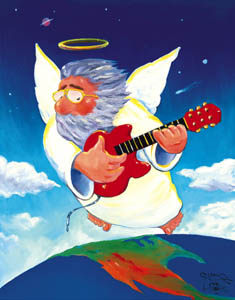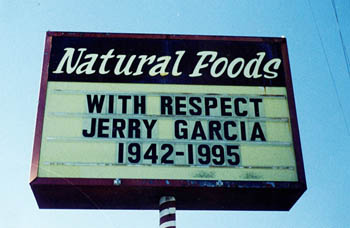![[Metroactive Music]](/gifs/music468.gif)
[ Music Index | Santa Cruz | Metroactive Home | Archives ]
The Ultimate High: Stanley Mouse's portrait of Jerry in the clouds with halo.
Miss Him When He's Gone
Ten years ago, the world lost Jerry Garcia. But the music never stopped.
By Art O'Sullivan
There was something strange in the air that Tuesday night, summer of '95: the breeze was balmy but edgy, and the evening seemed extra dark and somehow uneasy. I had agreed to be an emergency sub for a friend disc-jockeying a midnight radio show--something I would normally be happy to do--but this night things felt wrong and I just did not want to be there. I was playing a good old Grateful Dead tape--something to at least keep me happy. The strains of a "Scarlet Begonias/Fire on the Mountain" medley showcasing Jerry Garcia's lilting guitar were lifting my spirits. A woman phoned to express her elation at discovering a Dead concert on the radio. We talked some and I said, "There won't always be Dead shows to go to."
She agreed, then asked, "Do you want to go to one sometime?"
Uh--well--I settled on "maybe."
The caller made sure I was not married, then gave me her phone number and we left it at that.
The next morning, my friend Terry phoned from L.A.
"Hey, what's up?" I greeted.
Silence.
"You haven't heard?"
No, I hadn't.
"Jerry Garcia is dead."
Garcia had died of heart failure around 4:20am that morning, Wednesday, Aug. 9, 1995, at a Marin County drug rehabilitation center which he had checked himself into. We'd all known for years that Garcia had health issues--diabetes, chain-smoking and a hard-drug habit--so this news was not a surprise, but it was a terrible shock.
I got off the phone quickly as I felt a great well of tears rising up to burst.
As word of Garcia's passing spread, people congregated in special places, and even public officials honored the iconoclast-turned-unwilling icon. Wednesday afternoon at 4:20, people gathered at what was then known as "hippie corner" at Cathcart and Pacific. In San Francisco, the mayor ordered a tie-dye flag flown at half-staff over City Hall, and that night the faithful gathered at the corner of Haight and Ashbury. In New York, Deadheads lit candles at Strawberry Fields, the John Lennon memorial in Central Park. Even President Clinton took time to pay his respect.
The national media could not help but recognize the public outpouring of grief at Garcia's passing. That night on ABC's Nightline, host Ted Koppel invited Sen. Patrick Leahy (D-Vermont) and singer David Crosby (Crosby, Stills & Nash) to pay tribute to Garcia as a fallen hero and a friend.
Not everyone saw it that way. Radio commentator Rush Limbaugh said good riddance to a drug addict--society would be better off without him. (Could we roll that tape now, please?)
The most surprising and impressive tribute I caught was on PBS's staid MacNeil/Lehrer NewsHour--constituting proof that a major figure had passed from the scene. Standard practice on the NewsHour was to announce the death of a well-known performing artist at the very end of the opening news summary, then show a performance clip at the end of the program. But on Aug. 9, 1995, during the news summary, after announcing Garcia's passing, instead of switching over to the usual feature analyses, the NewsHour segued directly to a clip of the Grateful Dead, circa 1974, performing the traditional GD standard "I Know You Rider."
There was Jerry Garcia in his matching black frizzy hair, beard and T-shirt and tinted spectacles, singing an appropriate verse:
I wish I was a headlight on a
northbound train
Part way through the second reading of the line beginning "I know you rider ... ," the TV picture suddenly froze as Garcia's immobile face gazed in our direction, while the music continued without him: "... gonna miss me when I'm gone." On the word "gone," the sound phased out to silence and the picture faded to black.
And that was the end of the news summary on the NewsHour.
Dead But Not Forgotten: Santa Cruz mourns the morning after.
Also the end of the party--the end of the '60s--that mythical, officially bygone era that Garcia, the Dead and their Deadhead fans had kept alive and dancing for an extra quarter century. But no more encores. Jerry Garcia had left the building.
Millions grieved for a man whom most had never met but whom many felt they knew and that he knew them. Even in the inherently communal experience of a Grateful Dead concert, each person in attendance could get the feeling that Garcia was playing every note and chord for him or her alone.
A few days later, the Santa Cruz Sentinel ran the following headline: "Jerry Garcia's finger rests in county folklore." When Garcia was 4 years old and staying with his grandparents in Lompico, his brother accidentally chopped off most of Jerry's right middle finger with an ax. A few months later his father was swept away by a river in Northern California and drowned. His teenage years turned hellish, and Garcia took solace in self-medication and music.
He carried an acute awareness of mortality and how quickly everything can all be gone. Might as well make the best of life while you can--let the good times roll. Forget your troubles and dance.
In 1989, Garcia told Musician magazine LSD had affected his music: "Just the thought that anything is possible, clearly. From here on in anything is possible."
The original idea was for the band to drop acid and play without a plan in front of a psychically lubricated audience and let that audience guide the musicians through uncharted realms. Garcia played the tune while thousands engaged in mass civil disobedience and--despite intermittent police harassment--got away with it for 30 years.
Nothing is forever, nothing is secure. For that matter, nothing is real. Enjoy HERE AND NOW to the fullest--whether it's really happening or not. Don't play it safe--take chances.
The Music Played the Band
I took a chance on my first Grateful Dead show. Didn't drop acid, but did spring for a ticket. No one--not even the Dead themselves--could dictate or predict which times they'd be awesome or awful, and if my first Dead show had been one of the latter kind, there would not have been a second. My ticket did not say "legendary transcendent show tonight." We sat in the balcony, front left, and the Dead played OK the first set. But during the second set, by the time they kicked into "Good Lovin'" and shined the floor lights on the heads of dancing thousands and everybody went nuts--well, they had me.
Among Garcia's and the Dead's major influences were boogie-woogie, urban blues, bluegrass and rhythm & blues. That's a whole lot of blues--all of them expressing a shared understanding about suffering, love and death that was unique to the blues. Start with the pain, then shake it off while tripping out on the dance floor. Mainly they wanted to give the people something to dance to.
Garcia would sing the story--in a weak voice but with great emotional power--then seize the melody and discuss it with his guitar, rework it, take it places. Convey anxiety, fear, love, lust and unfolding the multilayered wonders of the universe. And it had a beat you could dance to. Endless experimentation, endless jams, repetition with variation, acid grooves.
That guitar had the purest tones, its crying melting into singing until we all felt better.
Q. Why do Deadheads swirl their arms
when they dance?
To observers and participants, rock & roll has become the new religion of the younger generations. The Grateful Dead's spiritual vision embodied freedom and kindness--celebrated at the concerts and carried beyond.
"You never knew where Jerry was going to take you," recalls one friend and concert veteran.
Another friend, who is highly sensitive but doesn't do drugs yet attended 150 Dead shows, started feeling anxious one time during an intense jam. Then she got a telepathic message that she felt came directly from Garcia: "I won't take you anywhere you don't want to go." And he didn't.
When Jerry would miss a vocal note horribly, or forget the words, or mess up on guitar, we'd all cheer and he'd just grin--then often go on to play something truly inspired. Most GD fans did not worship Garcia, but we did love him unconditionally.
Not Fade Away
So, now that it's all over, what's left?
Raves are the direct descendants of the acid tests. They still attract the young and scare the straight.
The Dead played lots of free concerts and benefits, and usually let fans record their shows with full knowledge that they would pass copies around. Nowadays, rock stars are almost expected to perform gratis for causes, and progressive artists circumvent big record companies and build their own fan bases by offering their music for free on the Internet.
Dead-style jamming led to jam bands, who carry on the experimental music and dance tradition. GD cover bands keep popping up like mushrooms in a cow pasture.
To this day, as often as not, there'll be some guy attempting to play Grateful Dead songs on Pacific Avenue. It's OK to sing along.
Love that's real will not fade away.
[ Santa Cruz | Metroactive Central | Archives ]
Copyright © 2005 Metro Publishing Inc. Maintained by Boulevards New Media.
For more information about Santa Cruz, visit santacruz.com.
![]()

Illustration by Stanley Mouse
I'd shine my light through the cool
Colorado rain

Photograph by Betsy Jones
A. To keep the music out of their eyes.
Art O'Sullivan hosts 'The Golden Road' program, which features Grateful Dead for nonbelievers, Wednesdays from 3 to 6pm on KZSC-FM Santa Cruz (88.1).
From the August 3-10, 2005 issue of Metro Santa Cruz.